What Is The Equivalent Of Film Speed In Digital Cameras Brainly
Crime Scene and Evidence Photography — Camera and Lighting
Steven Staggs
© 2014 from the book Crime Scene and Show Photography, second Edition
Overview
As mentioned in the outset chapter, a standard for photographs of law-breaking scenes and evidence is that the photographs must be of sufficient quality to be admissible in a court of constabulary. Crime scene photographers must understand how to get the correct results when using their cameras and lighting equipment for a variety of subjects and in a variety of lighting weather.
The Camera
The camera used most ofttimes in crime scene investigations is the Digital SLR (single lens reflex) photographic camera. Digital cameras which have twelve megapixel, or greater, image sensors and manual exposure settings (in addition to any automatic or programmed exposure modes) are commonly suitable for crime scene and evidence photography.
One of the most important considerations in selecting digital cameras is the quality of the image sensor. Virtually image sensors that are twelve megapixels or greater can produce photographs capable of enlargement to 16" ten 20" for courtroom exhibits. There are many other factors involved in the quality of digital photographs that too must exist considered when selecting digital photography equipment, such equally shut-upwards capabilities, availability of accessories and even the printer used to impress the digital photograph.
Automated vs. manual photography
About modernistic cameras have dependable automatic exposure systems built right in the camera. Xc percent or more than of the photographs taken at nearly criminal offence scenes can exist accomplished with a photographic camera prepare in an automated manner. It does become necessary, however, to know when the automatic functions of the photographic camera volition result in poor photographs and then you can brand adjustments or change techniques (more data about exposure adjustments and techniques are presented in the next section of this chapter).
Technical Photography
The blazon or style of photography used in photographing crime scenes and evidence is called technical photography. Crime scene photographers must accept high quality technical photographs to insure the photographs can be used in the investigation and ultimately in courtroom.
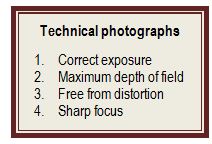
Technical photographs are photographs that show as much detail or information about the view or object pictured as possible. The best technical photographs accept four characteristics. They are correctly exposed, take maximum depth of field, are free from distortion, and are in sharp focus. While frequently in that location are conditions that make this difficult or impossible (east.g., close-up photographs will ever take shallow depth of field), crime scene and evidence photographers must strive to take photographs with these characteristics.
Correct exposure
Technical photographs must exist correctly exposed. Correct exposures are necessary for the film to capture detail in all parts of a scene, including highlight areas and shadows. Underexposed photographs lose detail in the shadows while overexposed photographs lose particular in the highlight areas.
Exposure is controlled by the shutter speed and lens aperture. Most cameras tin can exist operated in manual and automatic modes. Automatic systems and automated flash units produce acceptable results in almost normal situations. Even so, in some situations the automatic exposure systems may produce incorrect exposures. Some common problem lighting situations to be aware of include highly cogitating scenes, vivid sun lighted scenes with deep shadows, and dorsum lighting. In these situations you lot should consider metering off an 18 percent gray card, bracketing exposures, or wink fill up.
Ambient light (existing light) exposures tin can ofttimes be metered with the camera'southward internal exposure meter or an external exposure meter. However, earlier relying on whatsoever reflected light exposure meter, you should determine if the meter will be providing an authentic reading due to the subject or background about to be photographed. Exposure meters use 18 percentage reflectance in determining exposure. If you are photographing a scene that does non have 18 pct reflectance, the exposure reading can be in fault. For case, when photographing a law-breaking scene in the snow, an exposure meter will, as always, base of operations its exposure settings on xviii percentage reflectance. Since the subject affair in the photograph is nigh all white, the meter will provide exposure settings that outcome in an underexposed photograph. Much of the particular in the photo will be lost. A second instance would be a dark area of a scene, such as a section of charred wall at an arson scene. The exposure meter will base its settings on 18 percent reflectance and would provide exposure setting that outcome in an overexposed photograph. Much of the item in the charred wall volition be lost.
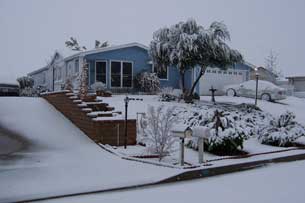 |
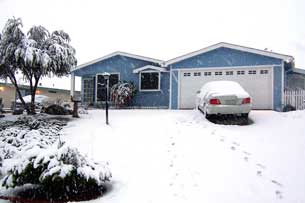 |
When using ambient calorie-free for criminal offence scene photographs you lot can insure authentic exposures by using an 18 percent gray card. Position the 18 percent grey bill of fare in front of the exposure meter, or in front end of the camera lens if you lot are using the camera'south exposure meter, to obtain the correct exposure settings. Be sure the ambient light is falling on the eighteen percentage gray card the aforementioned as it is falling on your scene. Use the settings indicated past the exposure meter for the photograph. If you are using a photographic camera in an automated exposure manner printing the "automatic exposure lock" (AEL) button on the camera while pointing the lens at the gray card to lock the exposure settings for the photo.
Bracketing
Our eyes can perceive a peachy range of contrast (nosotros can run across highlights and at the same time we tin can encounter details in shadow areas), far greater than whatsoever digital camera sensor or flick can capture. When nosotros try to photograph detail in the shadows the brighter areas will exist over exposed. In this type of lighting situation, bracketing exposures should be considered. Bracketing will provide a series of photographs at different exposures.
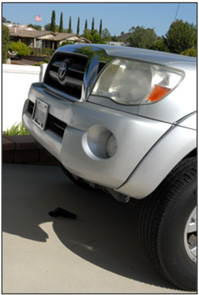 |
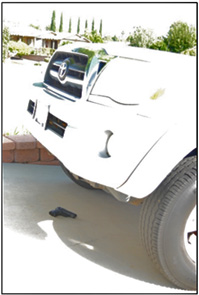 |
Bracketing involves making a serial of exposures of the same subject field at dissimilar exposures, normally at one stop or one-half cease intervals. Some cameras tin can be gear up to automatically bracket at selected exposure differences from the metered exposure.
High Dynamic Range Photography
With bracketing you may take two or more than photographs to look at to see all the detail in the highlights and shadows in the view. A way to reduce the two or more photographs to one photograph is to use High Dynamic Range (HDR) photography.
High-dynamic-range photographs are more often than not accomplished by capturing multiple bracketed photographs, and so merging them into a single HDR image.
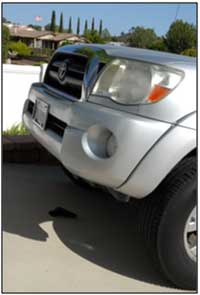 |
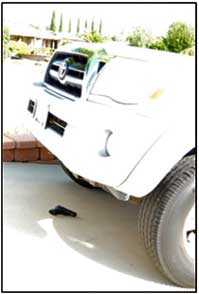 |
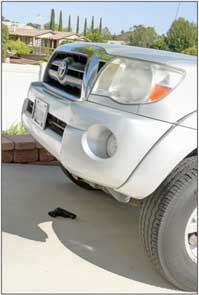 |
To evidence detail in highlight and shadow areas in one last HDR photograph you can take two photographs, ane exposed for the highlight surface area and one exposed for the shadow area. Then the two images are merged, or "fused," using a computer program such equally HDRsoft® Photomatix® or Adobe® Photoshop®.
Flash Fill
One more valuable technique for insuring accurate exposures, specially for scenes with deep shadows, is flash fill. In scenes illuminated by bright sunlight at that place will normally exist dark shadow areas. Sometimes bear witness is located in the shadows. Detail in the deep shadow areas may exist lost when the exposure is based on the overall brightness of the scene. With the utilise of flash make full, the brightness level in the shadow areas can be raised to the overall brightness of the scene.
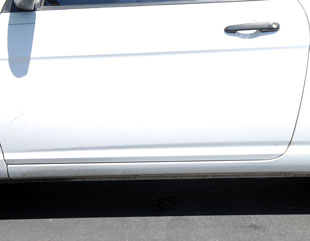 |
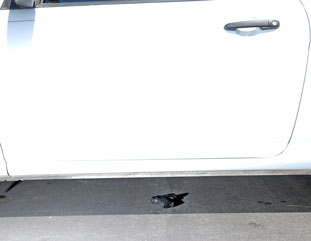 |
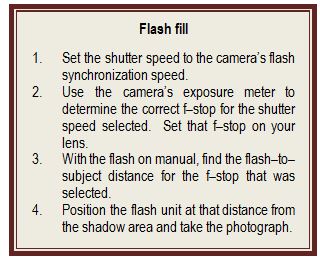 Many cameras with dedicated TTL (through-the-lens) flash systems tin can provide automatic flash fill. If you have a dedicated TTL flash arrangement consult the equipment instruction transmission for instructions on using flash fill up in the camera'due south automatic exposure style.
Many cameras with dedicated TTL (through-the-lens) flash systems tin can provide automatic flash fill. If you have a dedicated TTL flash arrangement consult the equipment instruction transmission for instructions on using flash fill up in the camera'due south automatic exposure style.
You can also use a camera and an electronic wink unit in transmission modes for flash make full. First you must set the camera'southward shutter speed to the photographic camera's flash synchronization speed (ordinarily one/60 or 1/125 second). And so apply the photographic camera's exposure meter to determine the correct f-stop for the shutter speed selected. Set that f-stop on your lens. With the flash on manual, discover the flash-to-subject altitude for the f-stop that was selected (the wink-to-subject distance for each f-stop is unremarkably displayed in a chart on the back of the electronic wink). Position the flash unit at that distance from the shadow surface area and take the photograph.
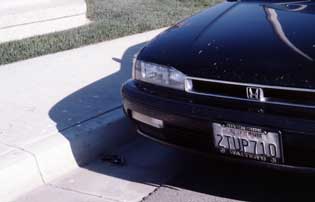 |
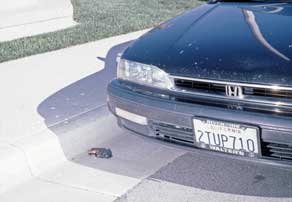 |
You may wish to use a flash remote cord so you can take more flexibility in choosing the proper angle to direct the electronic wink into the shadows.
Maximum depth of field
Technical photographs must accept maximum depth of field. Depth of field, oft called the plane of sharpness, is the area in a photo where objects are in precipitous focus. Criminal offense scene and evidence photographs should have every bit much in focus as possible (a deep plane of sharpness). This is because out of focus areas of a photograph can become issues in court. An opposing attorney could advise that you purposely acquired an area to be out of focus in a photograph to obscure some additional testify that could take been conspicuously visible if properly photographed.
There are three factors that bear on depth of field. They are the focal length of the lens on the camera, the photographic camera-to-subject altitude, and the lens aperture (f-cease) selected.
In crime scene and evidence photography you lot usually practise not have much command over the first two factors that affect depth of field. While long focal length lenses (e.g., 135mm) produce shallow planes of sharpness and short focal length lenses (e.g., 28mm) produce deep planes of sharpness, y'all will usually be using a 50mm lens (on a 35mm camera) because information technology provides the best visual perspective (lens selection and perspective will exist discussed in more detail later on). And while short camera-to-subject distances produce shallower planes of focus than longer photographic camera-to-subject distances, the distance betwixt the camera and your subject field volition depend on what needs to exist shown in the photograph. For case, close-upwards photographs require positioning the camera close to the subject resulting in shallow planes of sharpness.
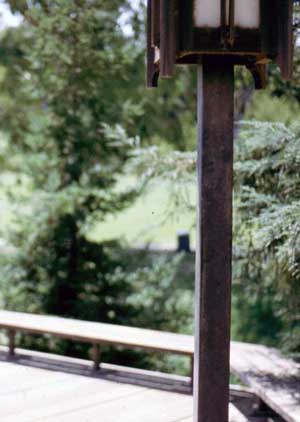 |
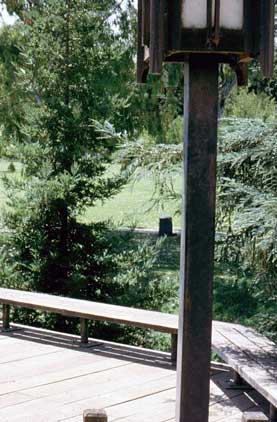 |
In crime scene and evidence photography, you normally control depth of field past lens aperture (f-stop) choice. Smaller lens openings (e.g., f/22) volition requite you deeper planes of focus while larger lens openings (e.chiliad., f/1.8) will give you shallower planes of focus.
It is often helpful to be able to determine the area that will be in focus earlier you take a photograph. For example, at a homicide scene you may want to accept a photo showing the human relationship between a gun on the flooring and the victim's torso. You have adamant that the body is seven feet from the camera and the gun is thirty feet from the camera. How can you lot exist sure that both the gun and the trunk volition be in sharp focus? Fortunately, there are three methods to decide the depth of field before yous take the photograph.
One method used to determine depth of field is to use the "depth of field preview lever" or button on most 35mm cameras. Pressing the depth of field preview lever allows you lot to manually "stop down" the lens aperture. As you look in the camera's viewfinder with the lens stopped down you will be able to see the area that volition be in focus.
A second method to determine depth of field is to use the depth of field chart that is located in the possessor'south guide that came with your lens. The chart volition show at what distances sharpness begins and ends for different f-stops and focused distances.
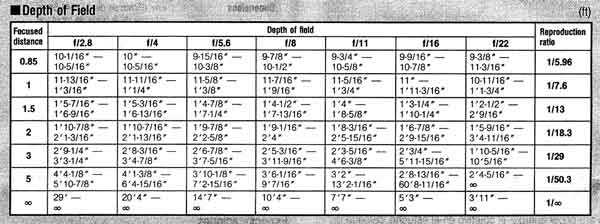 |
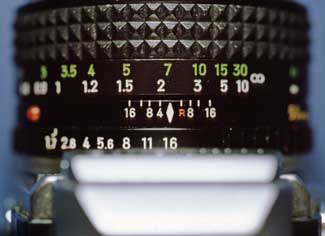 |
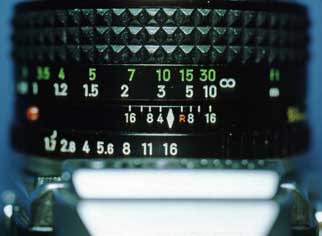 |

With coupon lawmaking "5off" at checkout
Free from distortion
Technical photographs must be as gratuitous from baloney equally possible and must have good perspective. The well-nigh common cause of baloney in photographs is improper lens selection. The lens that will provide the least distortion, and volition provide photographs that look similar to what y'all see at the scene, is the "normal focal length lens." You lot should use a normal focal length lens whenever possible (a 50mm lens is considered the normal lens for a 35mm camera). Long focal length lenses give a telephoto effect, and brusk focal length lenses produce wide-angle distortion. Distances in photographs taken with long and brusque focal lenses volition exist deceiving-the viewer will remember distances are shorter or longer than they actually were at the scene. This could create discrepancies in courtroom when a witness testifies to a altitude that appears in error when compared with a wide-angle photo on display.
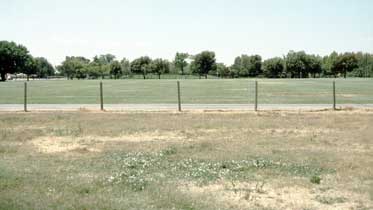 |
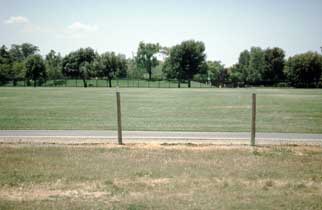 |
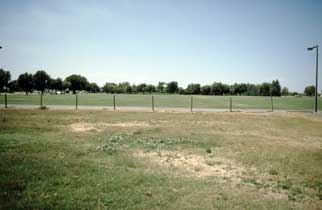 |
Technical photographs must besides take practiced perspective. To insure you have good perspective you should concord the camera level and at eye level (between iv 1/2 and 6 anxiety to a higher place the ground) whenever possible. This provides views in photographs that are easier for others to understand. Of course there are many times that you cannot hold the photographic camera level or at eye level–for example, you will point the photographic camera straight down to photo a footwear impression or position the camera near the ground to photograph evidence under a parked vehicle—simply hold the camera level and at eye level when you lot are able.
Abrupt Focus
Technical photographs must exist in sharp focus. To insure your photographs are in sharp focus keep the camera steady during the exposure. Y'all should mount the camera on a tripod if the shutter speed is less than 1/60 second and focus carefully. Also, maximizing depth of field will result in sharpness in a larger area of the photograph.
Flash Illumination
Types of flash illumination
Manual wink — When you employ a manual wink set up the lens f-end for the wink-to-subject altitude (the f-stop for each distance is usually displayed in a chart on the back of the electronic wink).
Automatic flash — Automatic wink units use distance ranges. Each range has a minimum and maximum distance. An f-stop is assigned to each range. Changing to a new range requires a change in f-terminate. When in automated flash, make certain the photographic camera shutter speed dial is set to the flash synchronization speed. When photographing a high key scene (light or reflective background) bracket exposures by opening up one or 2 f-stops.
Dedicated wink — The basic dedicated flash unit sets the right flash synchronization speed when the flash is in operation. It uses an automated sensor and distance ranges. You lot must set the appropriate f-cease for the distance range. More than advanced defended flash units may prepare both the correct wink synchronization speed and f-stop for the automated range selected.
Dedicated TTL wink — The dedicated TTL (through-the-lens) wink uses a sensor within the camera to command the duration of the flash. Employ smaller lens apertures for brusque distances and larger lens apertures for long distances. A "confidence lite" or a "warning light" volition bespeak whether a useable f-end was selected. If the equipment indicates in that location was not plenty light, select a larger lens aperture and rephotograph. Dedicated TTL wink units can usually exist used in manual and automatic modes, equally well equally TTL.
Problems with electronic wink photography
Distances — Light produced by an electronic wink falls off speedily. This effect is the inverse square police force of light (if the distance between the flash and subject is doubled, the illumination will driblet to 1 quarter of the original) and results in bright foregrounds and dark backgrounds. This tin can be a pregnant problem with flash photographs outdoors at night. It may be necessary to apply an automatic flash distance range that is twice the bodily flash-to-subject field distance or utilize manual flash settings (open up 2 f-stops). Other solutions include using a different lighting technique such every bit multiple flash, painting with light, or available light (utilizing existing light without electronic flash).
Reflective Surfaces — Automatic flash units can shut off besides soon due to reflected light from surfaces such as tile, white walls, or chrome. To avoid an underexposed photograph you may subclass to larger lens openings, diffuse the flash, bending the flash, or utilise manual flash.
Bounce wink
Y'all tin can use bounciness lighting for less contrast, softer lighting, reducing the intensity of the light, or to increase the bending of wink coverage. Bounciness lighting is accomplished by angling the flash to reflect the flash off a white or light colored surface, normally a ceiling. With manual flash add the distance upwardly and down for the flash-to-subject area distance, and and so add together in the absorbance loss (one to three f-stops). For bounciness lighting utilizing an automatic wink with the wink sensor facing the discipline, use a range for 2 or more times the bodily flash-to-subject distance.
Multiple flash
To illuminate large areas you can get good results by using several flash units positioned around the scene. The flash units can be triggered simultaneously by connecting them with sync cords or using photocell devices that remotely trigger the flash units when the camera-mounted flash fires. To rest the intensity of each of the flash units, altitude the flash units from the subject to provide the same f-stop value for each flash.
Painting With Light
Painting with low-cal is especially useful for lighting large crime scenes at night when a single wink volition not provide acceptable lighting coverage. Painting with light is also used at nighttime traffic standoff scenes to provide lighting for big areas.
Painting with light is accomplished by opening the camera's shutter for an extended period of time while a light source is moved around until the entire scene is properly illuminated. The light source can exist a flashlight or a spotlight, but the most effective light source is usually an electronic wink unit with a "test fire" button.
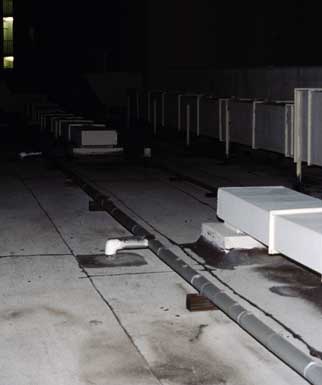 |
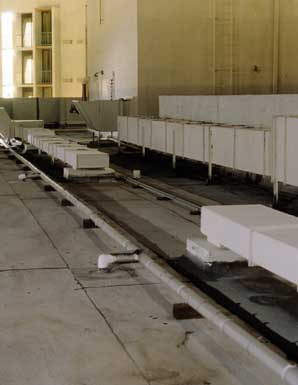 |
Painting with calorie-free is done with both the camera and electronic flash in their manual modes. Starting time you lot mountain the photographic camera on a sturdy tripod. Attach a locking cable release to the camera (some cameras crave an electronic cable release or have an extended time function built in to the photographic camera-see your camera'southward instruction manual for further information). Fix the shutter speed to the "B" (bulb) setting. 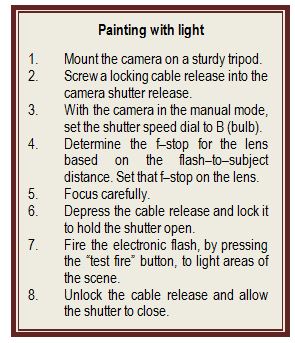 Determine the f-stop needed for the exposure based on the flash-to-subject distance (non the camera-to-subject distance) you volition be using. For instance, if you plan to position the flash about 20 anxiety away from each area yous intend to illuminate, y'all will be using. For example, if you plan to position the flash well-nigh 20 feet away from each area you lot intend to illuminate, select the f-finish for that distance (the f-stop for each altitude is usually displayed in a chart on the back of the electronic flash). Focus advisedly. Depress the cablevision release and lock it to concur the shutter open up. Fire the electronic flash, by pressing the "examination fire" button, to light areas of the scene. The number of flashes and bending of the flashes will depend on the size and graphic symbol of the scene. Exercise not point the flash direct at the photographic camera and go on yourself out of the view of the camera. When you cease lighting the scene, unlock the cablevision release assuasive the shutter to close.
Determine the f-stop needed for the exposure based on the flash-to-subject distance (non the camera-to-subject distance) you volition be using. For instance, if you plan to position the flash about 20 anxiety away from each area yous intend to illuminate, y'all will be using. For example, if you plan to position the flash well-nigh 20 feet away from each area you lot intend to illuminate, select the f-finish for that distance (the f-stop for each altitude is usually displayed in a chart on the back of the electronic flash). Focus advisedly. Depress the cablevision release and lock it to concur the shutter open up. Fire the electronic flash, by pressing the "examination fire" button, to light areas of the scene. The number of flashes and bending of the flashes will depend on the size and graphic symbol of the scene. Exercise not point the flash direct at the photographic camera and go on yourself out of the view of the camera. When you cease lighting the scene, unlock the cablevision release assuasive the shutter to close.
If there will be vehicle traffic through the scene during the painting with calorie-free exposure, the streaking of headlights and taillights volition record in the photograph. In such situations you may wish to cover the camera lens between flashes to block out the lights from vehicle traffic.
Bachelor Calorie-free Photography
Available lite photography is especially useful for large crime scenes at dark when a single wink will not provide acceptable coverage. Lighting for the photograph may exist from street lamps, parking lot lamps, or even moonlight. Available light from street lamps is frequently used at night traffic standoff scenes to provide lighting for large areas.
You may be able to become an acceptable exposure meter reading to operate your camera in manual settings. Automated cameras may also operate in low-light atmospheric condition. Many supplementary exposure meters provide accurate readings in very low-light conditions.
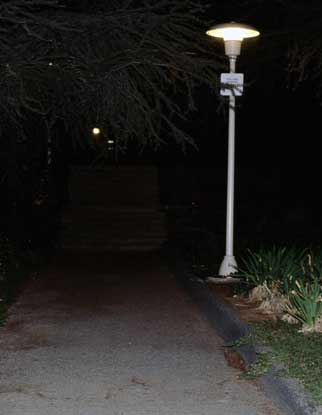 |
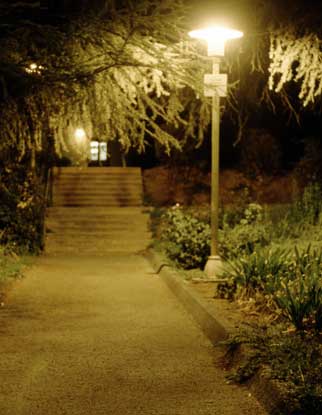 |
When obtaining an exposure meter reading practice not betoken the exposure meter straight at lights in your scene, or the photo you take will be underexposed. Since lighting is usually contrasty at nighttime (low-cal sources are many times brighter than shadow areas), determine which expanse of the scene is almost important and aim the exposure meter in that surface area. Apply a tripod and cable release to avert camera motion during the exposure. Bracketing exposures will assist to insure a good photograph.
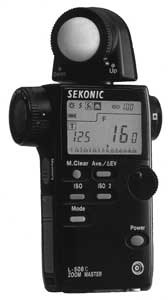 |
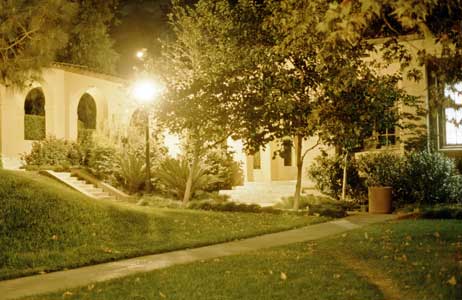 |
Summary
As the saying goes, "practice makes perfect." In photography exercise is essential not merely in learning how to operate your photographic camera equipment, merely is essential in reaching and maintaining the skill levels necessary to get a crime scene photographer. Reading instructions and looking at case photographs is usually not plenty. You must try the techniques and keep practicing them because practice does make perfect.
 Criminal offense Scene and Evidence Photography — Photographic camera and Lighting Copyright: © 2014 by Steven Staggs. Copyright for this article is retained past the writer, with publication rights granted to the Criminal offence Scene Investigation Network. This is an Open Access article distributed nether the terms of the Creative Commons Attribution-NonCommercial-NoDerivatives 4.0 International License which permits unrestricted noncommercial utilise, distribution, and reproduction, provided the original work is properly cited and not inverse in whatever style. Based on a work at http://www.staggspublishing.com/CrimeScenePhotography.html.
Criminal offense Scene and Evidence Photography — Photographic camera and Lighting Copyright: © 2014 by Steven Staggs. Copyright for this article is retained past the writer, with publication rights granted to the Criminal offence Scene Investigation Network. This is an Open Access article distributed nether the terms of the Creative Commons Attribution-NonCommercial-NoDerivatives 4.0 International License which permits unrestricted noncommercial utilise, distribution, and reproduction, provided the original work is properly cited and not inverse in whatever style. Based on a work at http://www.staggspublishing.com/CrimeScenePhotography.html.
About the Book
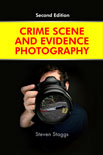
The information presented in this article is from the book
Crime Scene and Show Photography, 2nd Edition © 2014 by Steven Staggs.
Crime Scene and Bear witness Photography, 2nd Edition is designed for those responsible for photography at the criminal offense scene and in the laboratory. It may be used by police force enforcement officers, investigators, crime scene technicians, and forensic scientists. It contains instructions for photographing a variety of crime scenes and various types of evidence. It is a valuable reference tool when combined with training and experience. Criminal offense Scene and Show Photography is also a helpful resource for students and others interested in entering into the field of crime scene investigation.
Crime Scene and Prove Photography, 2d Ed may be purchased from the publisher.

With coupon lawmaking "5off" at checkout
About the Author
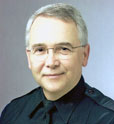
For the by 30 years Steven Staggs has been a forensic photography teacher and has trained more than four,000 crime scene technicians and investigators for police and sheriff departments, district chaser offices, and federal agencies. He is also a guest speaker for investigator associations, appears as a crime scene investigation skilful on Discovery Channel's Unsolved History, and provides consulting to law enforcement agencies.
Steve has extensive experience in law-breaking scene photography and identification. He has testified in superior court concerning his criminal offence scene, testify, and dissection photography and has handled high profile cases including a nationally publicized serial homicide case.
Steve is the author of the Criminal offence Scene and Evidence Photographer's Guide, a field handbook for crime scene and testify photography, which has sold over xl,000 copies and is in use past investigators in more 2,500 law enforcement agencies.
Steve retired in 2004 after 32 years in police force enforcement, merely continues to teach forensic photography and criminal offence scene investigations at a university in Southern California. He is the President of Crime Scene Resources, Inc. and Webmaster of the Crime Scene Investigator Network, the world'south almost popular Law-breaking Scene Investigation and Forensic Science website (www.criminal offense-scene-investigator.cyberspace).
Article submitted by the Writer
Article posted: July 1, 2104
Source: https://www.crime-scene-investigator.net/csp-cameraandlighting.html
Posted by: goblerespense.blogspot.com

0 Response to "What Is The Equivalent Of Film Speed In Digital Cameras Brainly"
Post a Comment